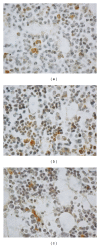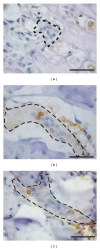Influence of bisphosphonate treatment on medullary macrophages and osteoclasts: an experimental study
- PMID: 23008775
- PMCID: PMC3449103
- DOI: 10.1155/2012/526236
Influence of bisphosphonate treatment on medullary macrophages and osteoclasts: an experimental study
Abstract
Nitrogen-containing bisphosphonates are widely used for treating diverse bone pathologies. They are anticatabolic drugs that act on osteoclasts inhibiting bone resorption. It remains unknown whether the mechanism of action is by decreasing osteoclast number, impairing osteoclast function, or whether they continue to effectively inhibit bone resorption despite the increase in osteoclast number. There is increasing evidence that bisphosphonates also act on bone marrow cells like macrophages and monocytes. The present work sought to evaluate the dynamics of preosteoclast fusion and possible changes in medullary macrophage number in bisphosphonate-treated animals. Healthy female Wistar rats received olpadronate, alendronate, or vehicle during 5 weeks, and 5-bromo-2-deoxyuridine (BrdU) on day 7, 28, or 34 of the experiment. Histomorphometric studies were performed to study femurs and evaluate: number of nuclei per osteoclast (N.Nu/Oc); number of BrdU-positive nuclei (N.Nu BrdU+/Oc); percentage of BrdU-positive nuclei per osteoclast (%Nu.BrdU+/Oc); medullary macrophage number (mac/mm(2)) and correlation between N.Nu/Oc and mac/mm(2). Results showed bisphosphonate-treated animals exhibited increased N.Nu/Oc, caused by an increase in preosteoclast fusion rate and evidenced by higher N.Nu BrdU+/Oc, and significantly decreased mac/mm(2). Considering the common origin of osteoclasts and macrophages, the increased demand for precursors of the osteoclast lineage may occur at the expense of macrophage lineage precursors.
Figures










Similar articles
-
Effect of alendronate treatment on the osteoclastogenic potential of bone marrow cells in mice.Bone. 1997 Apr;20(4):335-40. doi: 10.1016/s8756-3282(97)00006-9. Bone. 1997. PMID: 9108353
-
Bisphosphonate-osteoclasts: changes in osteoclast morphology and function induced by antiresorptive nitrogen-containing bisphosphonate treatment in osteoporosis patients.Bone. 2014 Feb;59:37-43. doi: 10.1016/j.bone.2013.10.024. Epub 2013 Nov 6. Bone. 2014. PMID: 24211427
-
Osteoclast recruitment in mice is stimulated by (3-amino-1-hydroxypropylidene)-1,1-bisphosphonate.Calcif Tissue Int. 1993 Jan;52(1):21-5. doi: 10.1007/BF00675622. Calcif Tissue Int. 1993. PMID: 8453501
-
Effect of monosodium olpadronate on osteoclasts and megakaryocytes: an in vivo study.J Musculoskelet Neuronal Interact. 2009 Apr-Jun;9(2):109-20. J Musculoskelet Neuronal Interact. 2009. PMID: 19516086
-
Mechanism of osteoclast mediated bone resorption--rationale for the design of new therapeutics.Adv Drug Deliv Rev. 2005 May 25;57(7):959-71. doi: 10.1016/j.addr.2004.12.018. Epub 2005 Apr 15. Adv Drug Deliv Rev. 2005. PMID: 15876398 Review.
Cited by
-
Extensive protein expression changes induced by pamidronate in RAW 264.7 cells as determined by IP-HPLC.PeerJ. 2020 May 21;8:e9202. doi: 10.7717/peerj.9202. eCollection 2020. PeerJ. 2020. PMID: 32509464 Free PMC article.
-
The effect of dipeptidyl peptidase-IV inhibition on bone in a mouse model of type 2 diabetes.Diabetes Metab Res Rev. 2014 Mar;30(3):191-200. doi: 10.1002/dmrr.2466. Diabetes Metab Res Rev. 2014. PMID: 24023014 Free PMC article.
-
Effect of alendronate on the mandible and long bones: an experimental study in vivo.Pediatr Res. 2015 Dec;78(6):618-25. doi: 10.1038/pr.2015.163. Epub 2015 Sep 2. Pediatr Res. 2015. PMID: 26331769
-
Bisphosphonate use in the horse: what is good and what is not?BMC Vet Res. 2019 Jun 24;15(1):211. doi: 10.1186/s12917-019-1966-x. BMC Vet Res. 2019. PMID: 31234844 Free PMC article.
-
Diverse osteoclastogenesis of bone marrow from mandible versus long bone.J Periodontol. 2014 Jun;85(6):829-36. doi: 10.1902/jop.2013.130376. Epub 2013 Sep 4. J Periodontol. 2014. PMID: 24003963 Free PMC article.
References
-
- Hiroi-Furuya E, Kameda T, Hiura K, et al. Etidronate (EHDP) inhibits osteoclastic-bone resorption, promotes apoptosis and disrupts actin rings in isolate-mature osteoclasts. Calcified Tissue International. 1999;64(3):219–223. - PubMed
-
- Benford HL, McGowan NWA, Helfrich MH, Nuttall ME, Rogers MJ. Visualization of bisphosphonate-induced caspase-3 activity in apoptotic osteoclasts in vitro. Bone. 2001;28(5):465–473. - PubMed
-
- Van Beek ER, Löwik CWGM, Papapoulos SE. Bisphosphonates suppress bone resorption by a direct effect on early osteoclast precursors without affecting the osteoclastogenic capacity of osteogenic cells: the role of protein geranylgeranylation in the action of nitrogencontaining bisphosphonates on osteoclast precursors. Bone. 2002;30(1):64–70. - PubMed
-
- Sudhoff H, Jung JY, Ebmeyer J, Faddis BT, Hildmann H, Chole RA. Zoledronic acid inhibits osteoclastogenesis in vitro and in a mouse model of inflammatory osteolysis. Annals of Otology, Rhinology and Laryngology. 2003;112(9):780–786. - PubMed
-
- Kwak HB, Kim JY, Kim KJ, et al. Risedronate directly inhibits osteoclast differentiation and inflammatory bone loss. Biological and Pharmaceutical Bulletin. 2009;32(7):1193–1198. - PubMed
LinkOut - more resources
Full Text Sources
Research Materials
